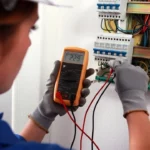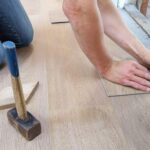What does the Trade Test entail?...
Trade Tests for the electrical industry trades will take place at a TAFE NSW College determined by the VTT. The test is supervised by a TAFE NSW technical expert and is usually conducted in one day taking approximately 5 to 6 hours to complete. The Trade Test is in two parts (Part A – Knowledge Test and Part B – Practical Skills Test). Details of each part have been described below to assist you to prepare for the test. You should familiarise yourself with knowledge requirements and the practical skill requirements of your selected trade.
PART A: Electrical Knowledge Test
The electrical knowledge test is designed to provide evidence that you can apply basic electrical trade knowledge to circuits and equipment to a level that meets acceptable requirements of electrical industry trades. The electrical knowledge test covers core knowledge requirements across the three electrical trades outlined in this document. The test includes:
| Knowledge Task | Detail |
|---|---|
| Basic dc circuits –analysis,
connection and measurement. |
- Single and multiple path dc series and parallel circuits:
calculations of current, voltage and resistance and meter connections / readings. |
| Basic single and three
phase circuits – analysis and measurement. |
- Single phase ac circuits: calculations of voltage, current and ac
power - Phasor relationships & analysis: current & voltage in ac resistive, inductive, capacitive circuits - Three phase supply: line and phase voltage measurement and socket outlet polarity. |
| Transformer connections,
analysis and measurement. |
- Star (Wye) and Delta connections of single phase transformers
to a three phase supply - Transformer turns, voltage and current ratios; - Single phase transformer winding connections. |
| Basic circuits for electrical
machines and controls. |
- Basic dc motor connections and analysis
- Basic single phase and three phase ac motor connections - Basic three phase ac motor starter circuit connections (main and control circuits). |
| Electromagnetic effects in
ac circuit components. |
- Adverse effects of electromagnetic induction
- Inductors and inductance - Magnetic poles of machines and solenoids. |
| Electrical equipment
testing and connection. |
- Mandatory testing of electrical equipment including continuity,
earth and insulation resistance - Using appropriate electrical test equipment and range selection. |
PART B: Electrical Practical Skills Test
| Practical Task | Detail |
|---|---|
| Cable preparation and
jointing techniques. |
|
| Flexible cable termination
and polarity. |
|
| Selection and connection
of circuit protection devices – single phase. |
|
| Installation of low voltage
enclosed wiring system – cables installed in conduit. |
|
| Installation of low voltage
un-enclosed wiring system – cables installed on a flat surface. |
|
| Isolation, disconnection,
testing and reversal of a three phase induction motor. |
|
| Electrical testing of
equipment and circuits to verify safety compliance and operational integrity. |
|
Not sure how to prepare for it?
There's plenty of material out there that you can get your hands on to help. Google "capstone material or exam" to see similar questions etc. We also recommend with STS the following publications:
- Jenneson & Harper, 2010, Electrical Principles for the Electrical Trades, 6th Ed, McGraw Hill
- Hampson & Hanssen, 2008, Electrical Trade Principles : a Practical Approach, 2nd Ed, Pearson
- Pethebridge & Neeson, 2010, Electrical Wiring Practice, 7th Ed, Volumes 1 & 2, McGraw Hill
Let us know if you need a hand - we'd be happy to help best we can.
Recognition of skills or prior learning in the electrical trade has definitely become more and more stringent, but as long as you are well prepared and have the right experience and skills you will be sweet. For migrants, it's definitely getting harder to get an electrician's licence - even if you do have the relevant qualifications and plenty of overseas experience. That's why our program for overseas electricians not only up-skills you with the AS/NZ 3000 standards and regulations, but ensures you are ready for a trade test. Some of our trainers have even sat on the VTT board or the like and will therefore make sure you are up to scratch before you finish up with us.
Anyway, whichever way you decide to go, best of luck with your licence!














good article,it is useful to me and others to know about this - especially those samples... I hope I pass
electrical trade test
Hi Lovepreet Singh,
Please call 1800 765 295 or simply fill in the form on the contact us page and we will be in touch